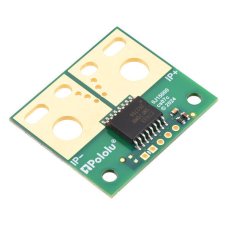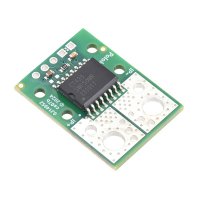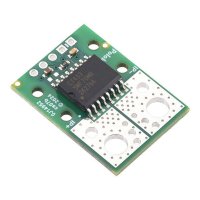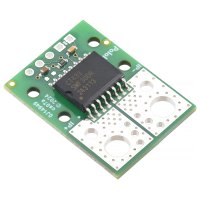This is the large version of a simple carrier for Allegro’s CT433-HSWF70MR TMR-based, electrically isolated current sensor that is optimized for high dV/dt applications and offers a high 1 MHz bandwidth with low noise. The typical primary current path resistance of the sensor IC is 1 mΩ.
| Part Prefix | Part Suffix | Range | Supply Voltage | Sensitivity | Zero Point | Size | PCB layers |
|---|---|---|---|---|---|---|---|
| CT433 | 70MR | ±70 A (bidirectional) | 3.0 V to 3.6 V | 14.3 mV/A | 1.65 V | 1.2″×1.4″ | 6 |
We are offering these breakout boards with support from Allegro Microsystems as an easy way to use or evaluate their CT432/CT433 tunneling magnetoresistance (TMR), electrically isolated, high-bandwidth current sensors that are optimized for high dV/dt applications; we therefore recommend careful reading of the applicable CT432 datasheet or CT433 datasheet before using this product. The following list details some of the sensors’ key features:

- CT432/CT433 sensors use Allegro’s patented XtremeSense™ TMR (tunneling magnetoresistance) technology for high accuracy, high bandwidth, electrically isolated current measurements.
- Sensor can be inserted anywhere along the current path and be used in applications that require electrical isolation.
- 1 mΩ primary current path resistance in the sensor IC, and the PCB is made with 2-layer (compact versions under 50A), 4-layer (compact versions 50A and up), or 6-layer (large versions) 2-oz copper, so very little power is lost in the module.
- TMR sensing rejects common-mode fields, so the orientation of the sensor relative to uniform external magnetic fields (e.g. the Earth’s magnetic field) has less effect on the measurement.
- Optimized for high dV/dt applications, allowing the sensor to be used in switching applications.
- High-bandwidth 1 MHz analog output voltage proportional to AC or DC currents.
- Typical 300 ns response time.
- Output is not ratiometric (i.e. the zero point and sensitivity are independent of the actual supply voltage), which provides immunity from noisy supplies.
- Optional overcurrent fault output indicates when the current magnitude exceeds 110% of the maximum linear sensing range.
- Operating temperature range of -40°C to 125°C.
- Carrier boards, available in compact and large sizes, offer a variety of ways to insert it into the current path along with 0.1″-pitch (breadboard-compatible) power, ground, and output pins.
- 3.3V (CT433) and 5V (CT432) versions available.

The connection points are labeled on the silkscreen, which is on the bottom side of the compact versions and on both sides of the large versions. The bottom silkscreen also shows the direction that is interpreted as positive current flow via the +i arrow.
Details for item #5335:


This large carrier features the CT433-HSWF70MR, which is intended for nominal 3.3 V operation and is designed for bidirectional input current from -70 A to +70 A. This version can be visually distinguished from the other versions by the part number printed on the sensor IC, as shown in the left picture above (the bottom silkscreen also has a blank white box that can be used for adding customized identifying markings)
A compact carrier is also available for this sensor IC for more space-constrained applications or to evaluate the IC’s performance with a smaller PCB area and fewer copper layers for thermal dissipation.
Using the sensor

This sensor has five required connections: the input current (IP+ and IP-), logic power (VCC and GND), and the sensor output (VOUT).
The sensor requires a supply voltage of 3.0 V to 3.6 V to be connected across the VCC and GND pads, which are labeled on the bottom silkscreen. The sensor outputs an analog voltage on VOUT that is centered at 1.65 V and changes by 14.3 mV per amp of input current, with positive current increasing the output voltage and negative current decreasing the output voltage:
VOUT=1.65V+0.0143VA⋅IP
IP= VOUT–1.65V =(VOUT–1.65V)⋅70AV
0.0143VA
The output is not ratiometric, so the zero point and sensitivity are independent of the actual supply voltage.
The optional FLT pin is normally at VCC and is pulled low when the IP current magnitude exceeds 110% of the maximum sensing range. This pin only asserts while the fault condition is present (it is not latched).
Note: The datasheet warns that using the FLT (TEST) pin as a fault output rather than grounding it will reduce the sensor’s immunity to high dV/dt events. If you do not need the fault feature, you can externally connect this pin to ground. Alternatively, we have the ability to custom-assemble these boards with this pin grounded (which would also disable the fault feature). If you are interested in customization, please contact us.
Making connections to the board

You can insert the board into your current path in a variety of ways. The largest through-holes are 6.6 mm in diameter with 22 mm spacing. These can be used with 1/4″ or M6 screws for attaching various types of lugs or solderless ring terminals, or thick wires up to 4 AWG can be soldered directly to the board. The slots near the edge of the board can accommodate a 4-pin terminal block or other connector with a pitch between 7.5 mm and 9.5 mm. Examples of these kinds of connections are shown in the pictures below. Holes with 0.1″, 3.5 mm, and 5 mm spacing are also available as shown in the diagram above for connecting male header pins or terminal blocks, but please note that these connection options are generally not suitable for high currents and could limit the usable range of the sensor.






The FLT, VOUT, VCC, and GND pins work with 0.1″-pitch header pins and are compatible with standard solderless breadboards
Warning: This product is intended for use below 30 V. Working with higher voltages can be extremely dangerous and should only be attempted by qualified individuals with appropriate equipment and experience.
Schematic and dimension diagrams

The dimension diagram is available as a downloadable PDF (436k pdf).
Real-world power dissipation considerations

Depending on the version, the CT432 and CT433 can measure up to ±70 A. However, the sensor chip will typically overheat at lower currents. In our tests, we found that our 6-layer CT432/CT433 large carrier board could conduct about 55 A continuously without reaching the thermal limit for the IC. Our tests were conducted at approximately 25°C ambient temperature with no forced air flow.
The actual current you can pass through the sensor will depend on how well you can keep it cool. The carrier’s printed circuit board is designed to help with this by drawing heat out of the sensor chip. Solid connections to the current path pins (such as with thick soldered wires or large, tightly-secured lugs) can also help reduce heat build-up in the sensor and carrier board.
Warning: Exceeding temperature or current limits can cause permanent damage to the sensor. If you are measuring an average continuous current greater than 30 A, we strongly recommend that you monitor the sensor’s temperature and look into additional cooling if necessary.
This product can get hot enough to burn you long before the chip overheats. Take care when handling this product and other components connected to it.
Package Includes:
- 1 x Pololu 5335 CT433-HSWF70MR TMR Current Sensor Large Carrier -70A to +70A, 3.3V
Pololu 5335 CT433-HSWF70MR TMR Current Sensor Large Carrier -70A to +70A, 3.3V
- Brand: Pololu
- Product Code: NR-Pololu-5335-CT433-HSWF70MR-TMR
- Reward Points: 12
- Availability: In Stock
- रo 1,181.00
-
रo 1,134.00
- Price in reward points: 1181
-
- 12 or more रo 1,172.00
- 25 or more रo 1,120.00
- 96 or more रo 1,070.00
Related Products
Pololu 5313 CT433-HSWF50MR TMR Current Sensor Compact Carrier -50A to +50A, 3.3V
This is the compact version of a simple carrier for Allegro’s CT433-HSWF50MR TMR-based, electrically..
रo 906.00 रo 944.00
Pololu 5315 CT433-HSWF70MR TMR Current Sensor Compact Carrier -70A to +70A, 3.3V
This is the compact version of a simple carrier for Allegro’s CT433-HSWF70MR TMR-based, electrically..
रo 906.00 रo 944.00
Pololu 5317 CT433-HSWF30DR TMR Current Sensor Compact Carrier 0A to 30A, 3.3V
This is the compact version of a simple carrier for Allegro’s CT433-HSWF30DR TMR-based, electrically..
रo 831.00 रo 865.00
Tags: Pololu, CT433, HSWF70MR, Current, Sensor, Large Carrier






